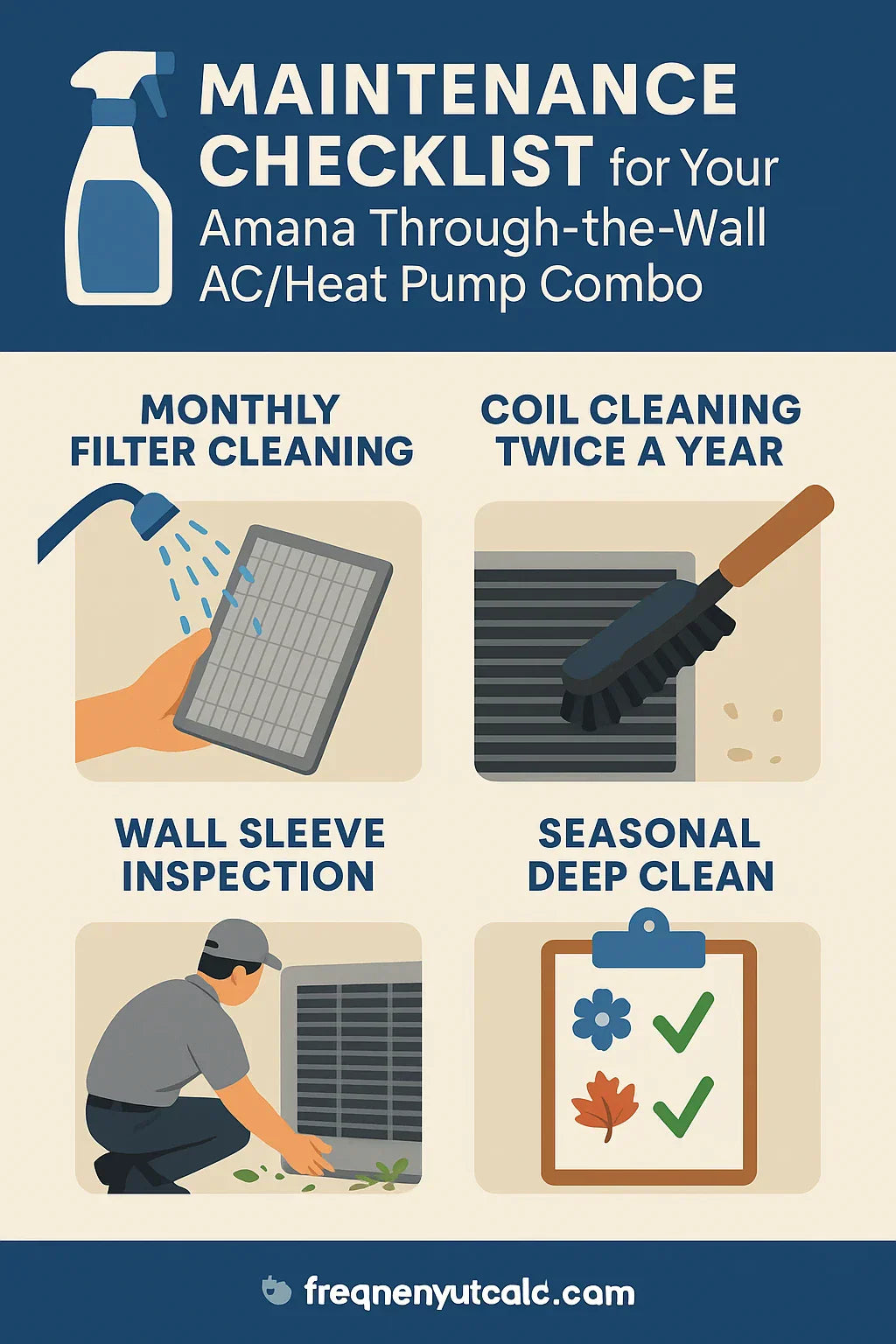🏠 Introduction: Why Maintenance Matters for Amana Wall Units
The Amana 9,200 BTU Through-the-Wall AC with Heat Pump is a versatile, energy-efficient choice for homeowners like Mark who need both heating and cooling in a single, space-saving system. But just like any HVAC appliance, proper maintenance is the key to long-term performance.
Neglect can lead to:
-
Rising utility bills
-
Dust and mold buildup
-
Compressor failure
-
Reduced heating/cooling output
This guide delivers Mark-approved, step-by-step instructions to help you:
-
Improve energy efficiency
-
Extend the unit’s lifespan
-
Reduce noise and odors
-
Keep comfort consistent year-round
🧹 1. Clean the Air Filter Monthly
📌 Why It Matters:
-
Clogged filters restrict airflow and strain the system
-
Reduces efficiency and increases power usage
🛠️ How to Do It:
-
Power off the unit
-
Open front panel and slide out the mesh filter
-
Rinse with warm water and mild dish soap
-
Let it dry completely before reinstalling
🧼 Mark’s Tip: Clean filters every 4 weeks during peak summer/winter use.
🔗 Energy.gov: Filter Maintenance Guide
🧊 2. Check the Condensate Drain and Pan
Blocked drainage can cause:
-
Water leaks
-
Mold/mildew growth
-
Damage to your drywall or floor
💧 What to Look For:
-
Water pooling under the unit
-
Musty smells
-
Condensation dripping down the wall
🧰 Steps:
-
Remove front panel
-
Use a flashlight to inspect the drain pan
-
Use a flexible brush or pipe cleaner to clear out the condensate channel
-
Spray a 50/50 vinegar solution to disinfect
🔗 Amana Troubleshooting Manual – Condensate Issues
🌀 3. Inspect and Clean the Coils (Twice a Year)
🌬️ Why It Matters:
-
Dust and debris reduce the coil’s ability to exchange heat
-
Can make your system overheat or ice up
🔧 How to Clean:
-
Gently vacuum indoor evaporator coil behind the filter
-
Use coil cleaner on outdoor condenser coil (rear of unit)
-
Avoid bending the fins — use a soft brush only
📆 Mark’s routine: Spring (pre-cooling) + Fall (pre-heating) checkup.
🔗 How to Clean AC Coils Properly
📦 4. Check the Wall Sleeve and Exterior Grille
The wall sleeve supports your AC and protects it from the elements. If improperly sealed or clogged, it affects drainage and airflow.
🔍 What to Inspect:
-
Rear grille for leaves, nests, or lint
-
Sleeve alignment and slope (should tilt outward 1/4”)
-
Exterior caulking and insulation
🧰 What to Do:
-
Remove debris from the back grille
-
Seal any exterior air gaps with weatherproof silicone
-
Clean weep holes for proper condensate flow
🔌 5. Test the Thermostat and Mode Settings
Issues with mode switching often come from:
-
Remote signal failure
-
Stuck reversing valves (for heat pumps)
🧪 Monthly Check:
-
Switch between Cool, Fan, and Heat modes
-
Confirm unit engages properly
-
Use a separate room thermometer to compare actual temperature
🧠 Mark says: “If the thermostat doesn’t trigger correctly, it may be time to reset or replace the remote.”
🔗 Amana Wall Unit Remote Programming Guide
🧯 6. Watch for Noise or Vibration Changes
Odd sounds can mean:
-
Loose fan blades
-
Compressor strain
-
Internal wear
🩺 Listen For:
-
Clicking (relay or capacitor)
-
Rattling (loose panels)
-
Buzzing or humming (electrical or coil ice)
🔧 Fix:
-
Tighten screws on front panel and grille
-
Inspect fan blades for obstruction
-
Call an HVAC tech if noise persists during operation
🔗 HVAC.com – Diagnosing AC Noises
🔄 7. Perform a Seasonal Deep Clean (Spring & Fall)
A full clean keeps the system balanced before the most demanding seasons.
🧽 Seasonal Checklist:
| Task | Spring Prep | Fall Prep |
|---|---|---|
| Clean filter | ✅ | ✅ |
| Clean evaporator coil | ✅ | ✅ |
| Clean condenser coil (rear) | ✅ | ✅ |
| Clear wall sleeve debris | ✅ | ✅ |
| Check heating mode | ❌ | ✅ |
| Check cooling mode | ✅ | ❌ |
| Vacuum interior air vents | ✅ | ✅ |
📆 Mark’s Annual Maintenance Calendar
| Month | Task |
|---|---|
| January | Check heating output, clean filter |
| March | Inspect coils, test cooling mode |
| May | Full spring clean |
| July | Replace remote batteries |
| September | Full fall clean, test heating mode |
| November | Inspect and clean condensate drain |
🛑 When to Call a Professional
If you encounter any of the following, contact a certified HVAC technician:
-
Persistent water leaks
-
Electrical smells or tripped breakers
-
Compressor shuts down frequently
-
Inconsistent temperatures despite setting
🔧 Service visits typically cost $120–$250, but can prevent major repairs down the line.
✅ Final Maintenance Quick-Reference Checklist
✅ Clean filter monthly
✅ Clean coils twice a year
✅ Inspect wall sleeve and exterior grille
✅ Check condensate drain pan
✅ Test thermostat and modes
✅ Perform full spring/fall deep clean
✅ Monitor sounds and unusual operation
✅ Call for service if needed
In the next topic we will know more about: Troubleshooting Guide: What to Do If Your Wall Unit Isn’t Heating or Cooling Properly







